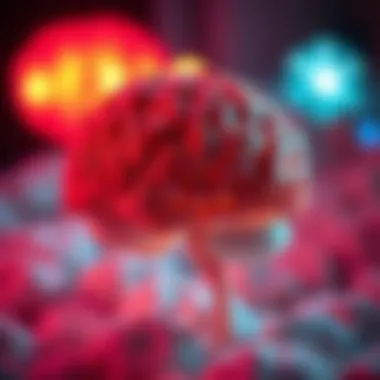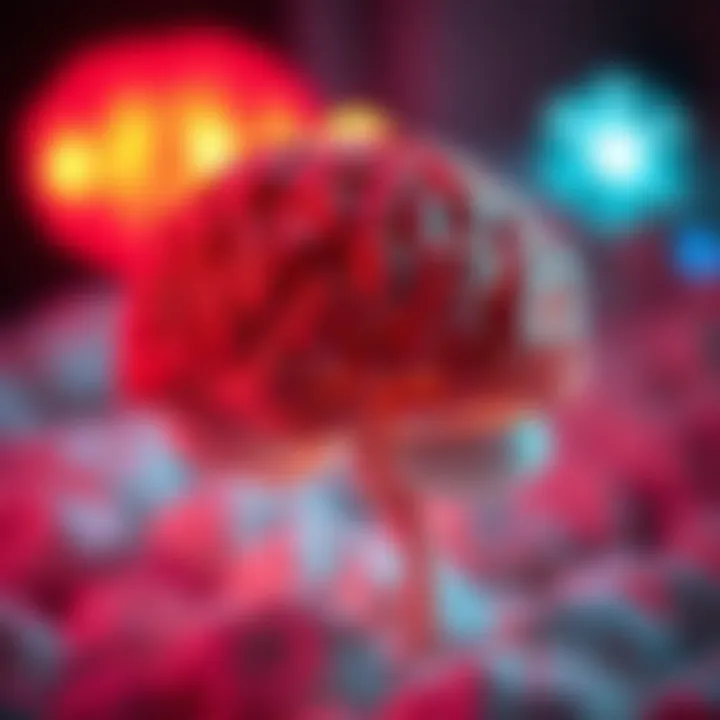Understanding Nighttime Sugar Cravings in Diabetes


Intro
Navigating the sweet temptations of the night can be a tricky path, especially for those managing diabetes. Nighttime sugar cravings can creep up on anyone, turning a peaceful evening into a battleground of temptation. Understanding the intricate relationship between these cravings and diabetes is vital. This exploration will unpack the various elements that contribute to nocturnal urges for sugary snacks, diving into physiological responses and psychological triggers. Armed with this knowledge, individuals can better navigate their dietary choices and maintain balanced blood sugar throughout the night.
Understanding Nighttime Sugar Cravings
Nighttime sugar cravings aren't just a passing fancy; they can signal deeper physiological and psychological dynamics at play. Cravings often stem from a body’s cues rather than simple hunger or want. For people with diabetes, these signals can be more pronounced due to fluctuations in insulin levels and blood sugar. At night, these fluctuations may lead to feelings of emptiness, prompting a desire for quick energy sources like sugars.
The Biological Clock and Sugar Cravings
Our biological rhythms impact when we feel hungry or full. As the evening sets in, metabolism slows down, making the body more susceptible to wanting quick, energy-dense foods to counteract the fatigue. The science behind this might be tied to the body’s natural circadian rhythms, which govern various biological processes. If someone has not consumed enough during the day, their body might react by ramping up cravings as they head toward night.
Emotional Triggers and Sugar Needs
It’s not all biology, however. Nighttime often brings with it a sense of stillness, allowing emotions to surface. Stress or anxiety from the day might lead to reaching for a sweet treat, seeking comfort in the sugary taste. For individuals managing diabetes, differentiating between genuine hunger and an emotional craving is crucial. The act of eating can become a coping mechanism rather than a response to hunger, complicating dietary management.
Strategies for Managing Nighttime Cravings
Understanding the mechanisms behind nighttime cravings is just the first step. Strategies to handle these cravings can empower individuals to make better choices while preserving their health. Here are several methods to consider:
- Plan Your Meals: Ensuring balanced meals during the day can help stave off late-night cravings. Incorporate proteins, fibers, and healthy fats to keep blood sugar stable.
- Mindful Eating: Cultivating mindfulness, especially in the evening, allows one to better discern hunger signals versus cravings. Take time to reflect before reaching for a sweet snack.
- Healthy Alternatives: It may help to have healthier snacks on hand. Opt for carrot sticks, Greek yogurt, or nuts instead of sugary snacks.
- Stay Hydrated: Sometimes thirst can masquerade as hunger. Aim to drink plenty of water before reaching for snacks, especially at night.
"Cravings may not just be about hunger; they often tell a story that your body needs attention and care."
The Importance of Blood Sugar Monitoring
Monitoring blood sugar levels closely is particularly important for those with diabetes. Fluctuations can be expected not only due to food intake but also from stress, sleep quality, and activity levels. Keeping a food journal can help identify patterns surrounding nighttime cravings, which in turn can lead to more informed choices. Understanding these connections might not just alleviate the issues but enhance overall well-being.
As we explore this intersection of cravings, psychology, and diabetes management, it becomes clear that nighttime sugar cravings are more than just simple impulses. They are woven into the fabric of our emotional and physical states, requiring a thoughtful approach to better manage them.
Learn More
For further reading, visit resources such as National Institute of Diabetes and Digestive and Kidney Diseases or American Diabetes Association.
Prolusion to Nighttime Sugar Cravings
Understanding nighttime sugar cravings is crucial for individuals navigating the complexities of diabetes. These cravings can stem from a variety of factors, and they hold significant implications for blood sugar management. Not only do they provide insight into an individual’s metabolic state, but they can also reveal emotional or lifestyle-related influences that warrant attention.
The crux of the matter is that without proper understanding, these late-night urges can derail dietary plans and adversely affect glycemic control. Consequently, grasping the nature of nighttime sugar cravings equips individuals with knowledge vital for making conscious food choices, fostering both physical and emotional balance.
Defining Nighttime Sugar Cravings
Nighttime sugar cravings, in essence, refer to the intense desire for sweet foods that commonly manifest in the hours leading up to sleep. These cravings vary from mild urges to overwhelming desires, often appearing around the time when the body is winding down for the night. The psychological dimension is as significant as the physiological one; it’s not merely about the body’s needs but also about emotional and environmental cues.
While some may crave a simple cookie or a piece of chocolate, others might find themselves reaching for a full candy bar or ice cream, indicating a stronger craving at play. Such behaviors can result from various triggers, including stress, lack of sleep, or even hormonal fluctuations.
The Connection to Diabetes
For individuals with diabetes, the connection between these sugar cravings and their health can be particularly pronounced. In many cases, cravings can lead to poor dietary choices that spike blood sugar levels, making it vital to understand why they occur in the first place.
- Physiological Factors: The body's insulin response and fluctuations in glucose levels play a significant role in regulating hunger and cravings.
- Psychological Dimensions: Emotional triggers can exacerbate cravings, causing individuals to seek comfort in sugary foods, especially at night.
- Lifestyle Elements: Lack of regular meal patterns and nutritional balance can contribute to increased cravings.
Understanding these factors not only helps in managing cravings effectively but also sheds light on broader strategies for living well with diabetes.
Physiological Mechanisms Behind Sugar Cravings
Understanding the physiological mechanisms behind sugar cravings offers valuable insights, especially for individuals managing diabetes. It sheds light on why the body may crave sugary treats at certain times, particularly during the evening when the day's stresses often culminate. By recognizing these mechanisms, it becomes easier to address cravings thoughtfully and create healthier habits that support blood sugar management.
Hormonal Influences on Appetite
Hormones play a central role in regulating appetite and food cravings. Two key players in this process are ghrelin and leptin. Ghrelin, often dubbed the "hunger hormone," signals your brain that it's time to eat. On the other hand, leptin works to curb appetite, letting your body know it has enough energy stored. In diabetic individuals, these hormonal signals can become disrupted, potentially leading to increased hunger and cravings, especially for sugary foods.
For instance, if you’ve had a busy day and skipped meals, ghrelin levels may surge, signaling your body to seek quick energy – often in the form of sugar. This hormonal imbalance can be especially pronounced in the evening when fatigue sets in. Paying attention to meal timing and hormone fluctuations can greatly affect your cravings and energy levels.


Impact of Blood Sugar Levels
Blood sugar levels fluctuate naturally throughout the day, influenced by what we eat and how often. After consuming carbohydrates, your blood sugar levels rise, leading to a release of insulin to help cells absorb glucose. However, if blood sugar levels drop too low later, perhaps due to inadequate meal planning or late-night snacking, the body sends urgent signals for quick sources of energy. This is often felt as a strong craving for sugary foods.
Monitoring blood sugar levels is critical, especially for those with diabetes. A sudden dip could not only lead to sugar cravings but also result in fatigue and irritability. By maintaining stable blood sugar levels through balanced meals, it becomes easier to curb these nighttime urges.
Brain Chemistry and Reward Systems
Our brains have intricate reward systems that respond to sugar consumption. When you eat sugar, neurotransmitters such as dopamine are released, making you feel good. This reaction builds a cycle where, over time, the brain starts to associate sugar with pleasure, leading to a craving response. This is particularly relevant in the evening when the brain may seek comfort and relaxation after a long day.
Moreover, chronic consumption of high sugar foods can alter brain chemistry. It can lead to increased cravings not only for sugar but also for carbohydrates and even junk food overall. As a result, nighttime cravings can become pronounced, leading individuals with diabetes into a loop that complicates blood sugar management. Being aware of how your brain uses sugar as a reward can help you develop healthier food choices, breaking this cycle of cravings.
The interplay of hormones, blood sugar levels, and brain chemistry creates a complex web that drives nighttime sugar cravings, particularly for those managing diabetes.
Recognizing these mechanisms equips individuals with the knowledge to navigate cravings more effectively, fostering healthier eating habits while managing diabetes.
Common Reasons for Nighttime Cravings
Nighttime sugar cravings are a common struggle for many, especially for those managing diabetes. Understanding the reasons behind these cravings can be the first step toward effectively addressing them. The factors influencing nighttime cravings usually extend beyond mere hunger. It's a complex interplay of emotional, nutritional, and biological elements, which can significantly impact an individual's health.
Stress and Emotional Eating
When the sun sets, many find themselves winding down from the day’s hectic pace. However, this period of relaxation can often bring unwanted companions: stress and emotional eating. Stress has a sneaky way of nudging people toward sugar-laden snacks. After a tough day, that tub of ice cream or bag of gummy bears can seem to whisper sweet nothings, leading to mindless munching.
"Stress eating is like putting a band-aid on a bullet wound; it might feel good in the moment, but it does nothing to solve the underlying issue."
For those dealing with diabetes, this habit poses a risk. Emotional eating often goes hand in hand with poor food choices, which directly influences blood sugar levels. Understanding the triggers of stress and how they lead to cravings can encourage healthier coping mechanisms, eventually steering individuals away from late-night snacking.
Lack of Nutritional Balance
Many individuals feel that eating is a mere matter of giving in to cravings. Yet, often it's a sign of an imbalanced diet throughout the day. If meals are lacking in essential nutrients, particularly protein and fiber, cravings can escalate when night falls.
Insufficient protein and fiber fail to sustain blood sugar levels adequately. This inconsistency can leave one feeling more vulnerable to cravings. For example, a salad devoid of protein or a dinner plate lacking in fulfilling whole grains can trigger desires for sweets later on. Eating a well-rounded diet during the day not only fuels the body but also curbs those sneaky nighttime urges, promoting better overall health and blood sugar control.
Circadian Rhythms and Appetite
There's a remarkable connection between our body's internal clock and our eating habits. Circadian rhythms regulate everything from sleep patterns to appetite. As the day turns to night, hormone levels shift, leading to increased cravings for some. It’s as if our bodies are programmed to want that sugar fix. Understanding how these rhythms function can aid in crafting more mindful eating habits.
Emphasizing a consistent eating schedule aligns with natural circadian rhythms. Disruptions due to late-night eating or inconsistent meal times can exacerbate the struggle with cravings. By being aware of these rhythms, one can create a more harmonious relationship between their body and their dietary choices, which, in turn, can lead to reduced instances of nighttime cravings.
The Role of Diabetes in Sugar Cravings
Understanding the relationship between diabetes and nighttime sugar cravings is crucial. Diabetes affects the way the body processes glucose, which can significantly impact cravings for sugary foods. People living with diabetes often experience fluctuations in blood sugar levels, leading to a complex interplay of hormonal influences and psychological factors that can trigger these cravings, especially at night.
Nighttime can be a vulnerable time for individuals managing their diabetes. After a long day, many might seek comfort in food to wind down, making it imperative to understand the motivations behind these sugar cravings. Recognizing the role diabetes plays not only helps in managing cravings but also enables individuals to develop strategies to mitigate their impact. It's all about proactive management and informed choices.
Effects of Type One Diabetes
Type One Diabetes (T1D) presents a unique challenge for nighttime cravings. In T1D, the pancreas generates little to no insulin, leading to potentially high blood sugar levels if insulin doses are not properly calibrated. This misalignment can trigger cravings for sugary foods due to the body's desperate need for quick energy sources.
Those living with T1D may find that their cravings are exacerbated at night, particularly if they have been physically active during the day. After exercise, the body often requires carbohydrate replacement, but due to insulin management complexities, one might find themselves reaching for sugary snacks to stave off low blood sugar or to treat a sudden drop. However, this approach can be a double-edged sword, ushering in a cycle of elevated blood sugar and subsequent cravings. Understanding the nuances of this interaction is vital for effective management.
Moreover, the psychological aspect cannot be ignored. Individuals may feel a sense of restriction from their dietary needs, leading to emotional eating at night. Developing a stable routine as well as proper monitoring of insulin levels can help mitigate these urges and keep cravings at bay.
Effects of Type Two Diabetes
Type Two Diabetes (T2D) presents a different set of challenges regarding sugar cravings, often rooted in insulin resistance. When the body's cells become less responsive to insulin, glucose remains in the bloodstream, contributing to heightened blood sugar levels. This scenario can provoke cravings for quick energy, particularly in the evening.
Many people with T2D might find themselves experiencing intense cravings after dinner, often driven by the body's misguided signals that insist on quick sources of energy. This urge can also be partially attributed to lifestyle factors such as stress or fatigue accumulated throughout the day. Understanding that these cravings stem not just from hunger but also from a physiological response can aid individuals in addressing their late-night eating habits with more awareness.
It's crucial for those managing T2D to consider their dietary choices throughout the day, as meal planning plays a significant role in regulating nighttime cravings. Effective strategies include focusing on balanced meals with sufficient protein and fiber during the day, minimizing the likelihood of sugar-induced hunger pangs later on.
Key takeaway: Understanding how diabetes intricately connects to sugar cravings is the first step towards managing them effectively. By recognizing the physiological and psychological triggers, individuals can better navigate their nighttime eating habits.
Managing Nighttime Sugar Cravings


Understanding how to navigate nighttime sugar cravings is vital for those managing diabetes. These cravings aren't just a nuisance; they can lead to emotional distress and disruption of blood sugar levels. Getting a grip on these urges can make a world of difference in maintaining stable glycemic control. By learning to manage cravings, individuals can bolster their overall health and make informed choices that prevent spikes in blood sugar.
Creating a Balanced Evening Routine
A well-designed evening routine can be a game-changer in curbing nighttime sugar cravings. Think about it: just as a car needs fuel, your body requires the right inputs to perform at its best. Prioritizing a balanced evening doesn’t mean loading up on snacks; instead, it emphasizes moderation and nutritional value.
Integrating various elements into your evening schedule can be effective:
- Meal timing: Eating dinner at a consistent time each night can help regulate appetite.
- Quality sleep: Aim for a full night's sleep. Poor sleep can lead to cravings, as your body seeks quick sources of energy.
- Calm environment: Wind down with relaxation techniques, such as gentle stretching or reading, to signal to your brain that it’s time to relax.
"When you set a routine, you establish boundaries," someone wise might say. This is especially relevant when it comes to ensuring you’re not mindlessly reaching for snacks just because it’s that time of night.
Implementing Mindful Eating Practices
Mindful eating practices allow you to take accountability for your food choices. This strategy can help you recognize your body’s signals and distinguish between actual hunger and cravings born from stress or habit.
Engagement in the process of eating can be insightful. Here are some practical tips:
- Focus on your food: Avoid distractions like TV or smartphones. Use all your senses—notice the texture, color, and aroma of what's on your plate.
- Go slow: Give yourself time to savor each bite. Setting your utensil down between bites can aid in this process.
- Listen to your body: Pay attention to sensations of fullness. It’s remarkably easy to munch away without realizing how much you’ve consumed. Reflecting on whether you’re hungry for a snack or just looking for comfort is critical.
Being mindful can shift your perception on eating, turning it from a mechanical act into a deliberate choice.
Choosing Healthier Alternatives
Navigating the snack aisle at night can be challenging, especially when those sugar-laden temptations are calling your name. However, knowing your options can leave you feeling empowered instead of defeated.
Opting for healthier alternatives doesn’t mean devoiding yourself of enjoyment. Here’s a list of alternatives that satisfy without compromising your health:
- Fruit: Fresh fruit, like berries or an apple, can provide natural sweetness without the added sugars found in processed snacks.
- Greek Yogurt: High in protein and low in sugar, Greek yogurt can be a filling snack that fulfills those cravings.
- Nuts: A small handful of almonds or walnuts can give your body healthy fats and stave off cravings.
End
In summary, managing nighttime sugar cravings requires a multifaceted approach. From establishing a thoughtful evening routine to practicing mindfulness in eating habits and making informed snack choices, each strategy plays a role in the bigger picture. By implementing these practices, individuals with diabetes can not only navigate cravings effectively but also enhance their overall wellness.
For more tips on nutrition for diabetics, consider checking out resources such as CDC Diabetes or American Diabetes Association.
Embracing these strategies can pave the way toward greater control over diet and health, allowing for a more fulfilling relationship with food.
Nutritional Strategies for Diabetics
Navigating the complexities of diabetes management involves more than just monitoring blood sugar levels; it also encompasses the choices made at meal times. The nutritional strategies a person adopts can significantly influence how they experience nighttime sugar cravings. These strategies serve as both a preventive measure against cravings and a means to mitigate their effects when they occur. By establishing a solid foundation of appropriate food selections, individuals can harness greater control over their dietary habits and ultimately enhance their overall well-being.
Prioritizing Low Glycemic Index Foods
When it comes to meal planning for those with diabetes, low glycemic index (GI) foods should be a top priority. The glycemic index ranks foods based on how they affect blood glucose levels. Foods with a low GI score release glucose gradually into the bloodstream, which helps in maintaining stable blood sugar levels. This stability can significantly reduce the likelihood of experiencing sudden cravings late at night.
Examples of low GI foods include:
- Whole grains (like quinoa and barley)
- Legumes (such as lentils and chickpeas)
- Non-starchy vegetables, which are packed with nutrients but low in calories
- Fruits like apples, pears, and berries, which provide fiber along with natural sugars
By consciously opting for low GI foods during the day, individuals may find themselves less prone to the pull of sugary snacks after the sun goes down.
Incorporating Sufficient Protein and Fiber
Protein and fiber are your best friends when it comes to managing cravings. Both nutrients contribute to feelings of fullness, thereby reducing the likelihood of late-night snacking. Protein helps to curb hunger hormones, keeping you satisfied longer. High-fiber foods take longer to digest, which also prolongs satiety. Incorporating a mix of these nutrients can create a powerful duo against sugar cravings.
Some excellent sources of protein include:
- Lean meats like chicken and turkey
- Fish and seafood, particularly fatty fish rich in omega-3s
- Low-fat dairy products, such as Greek yogurt or cottage cheese
- Nuts and seeds, which are also great for heart health
For fiber, consider:
- Vegetables, especially leafy greens
- Whole grains such as oats or brown rice
- Fruits, particularly those with edible skins


Hydration and Its Benefits
Many people overlook the importance of hydration, especially when it comes to managing cravings. Often, our bodies mistake thirst for hunger. For individuals managing diabetes, maintaining proper hydration can play a crucial role in minimizing cravings. When well-hydrated, the body functions optimally and is better equipped to regulate appetite.
To ensure hydration:
- Drink water throughout the day, aiming for about eight glasses or more depending on individual needs.
- Incorporate hydrating foods, like cucumber, watermelon, and oranges, which can also provide essential nutrients.
- Limit intake of sugary beverages, which can often trigger cravings for additional sweets later.
"Staying hydrated not only helps curb cravings but also supports overall metabolic processes essential for diabetes management."
By focusing on these nutritional strategies, individuals can create a balanced approach to evening eating habits. In turn, this may lead to enhanced control over nighttime sugar cravings and improved management of diabetes.
Behavioral Approaches to Curbing Cravings
Curbing nighttime sugar cravings is not merely a battle of willpower; it’s about understanding the mind’s role in food choices, especially for those managing diabetes. Behavioral approaches can integrate psychological techniques and practical strategies, fostering better food habits and enhancing one’s ability to resist the temptation of sugary snacks at night. Applying these approaches not only impacts blood sugar control but also promotes overall well-being.
It's essential to grasp that each individual's relationship with food is unique. Factors such as emotional state, past experiences, and even social settings play a part in shaping those nighttime cravings. Hence, understanding these behavioral triggers can be a game changer for many.
Cognitive Behavioral Techniques
Cognitive behavioral therapy (CBT) is a powerful tool in reshaping how one thinks about cravings and food. By emphasizing awareness and mindfulness, CBT encourages individuals to recognize and challenge negative thoughts associated with nighttime snacking.
- Identify Triggers: Keeping a food diary can unveil patterns that lead to late-night cravings. For instance, a person may notice that stressful days more often culminate in dessert binges. Recognizing these connections is the first step toward better control.
- Challenge Negative Thoughts: Often, there are irrational beliefs tied to food cravings, such as labeling oneself as 'bad' for enjoying a treat. CBT teaches individuals to reframe these thoughts. Instead of saying, "I might as well eat this because I already messed up today," one could think, "It's okay to indulge occasionally, but I will also enjoy healthier choices."
- Set Realistic Goals: Changing habits doesn’t happen overnight. People may find it helpful to set achievable targets, gradually reducing the frequency and quantity of late-night sugar intake. For example, a goal could be to swap out a heavy dessert for a piece of fruit two nights a week initially.
"It's less about the food and more about changing the mindset that drives those cravings."
Stress Reduction Techniques
Stress can be a silent adversary, fueling cravings with a side of anxious thoughts. Therefore, integrating stress reduction techniques can prove invaluable. Here are a few approaches:
- Mindfulness Meditation: Engaging in just a few minutes of mindfulness can help center one’s thoughts, making it easier to resist urges. By fully focusing on the present and appreciating other aspects of life, the urgency to snack may diminish.
- Breathing Exercises: Deep, controlled breaths can trigger the relaxation response in the body, countering the drive towards sugar as a comfort food. Focusing on the rhythm of one's breath can induce a state of calm, steering the mind away from cravings.
- Physical Activity: Regular exercise acts as a natural stress reducer. A brisk walk in the evening or some gentle yoga can shift one’s focus and boost mood hormones, creating a buffer against nighttime cravings. Incorporating these activities offers a healthier and more constructive outlet than reaching for sugar.
By understanding and implementing these behavioral strategies, individuals can take proactive steps in managing their cravings. It’s not about striving for perfection, but rather building a sustainable, healthier relationship with food.
Long-term Implications of Nighttime Sugar Consumption
Understanding the long-term implications of nighttime sugar consumption is crucial for individuals managing diabetes. The choices we make after the sun sets can echo through our physiological health, affecting not only our immediate well-being but also our long-term health outcomes. This section will explore specific elements related to the health risks and effects on glycemic control that arise from late-night sugar indulgence.
Potential Health Risks
Nighttime sugar cravings can lead to several health risks that individuals should be aware of. When the body consumes sugar, particularly at night, it can trigger a cycle of cravings. This cycle often leads to overeating, which can significantly impact one’s overall health.
- Weight Gain: Consuming excess sugar right before bed can contribute to weight gain. The body tends to store unused energy as fat, and indulging in sugary snacks can push the caloric intake over the edge, especially when coupled with a sedentary evening routine.
- Increased Risk of Heart Disease: Research suggests that high sugar intake is linked with elevated risks of heart disease. Late-night eating patterns that incorporate sugary foods may contribute to higher blood pressure and cholesterol levels, factors known to strain cardiovascular health.
- Deterioration of Sleep Quality: Sugar can cause energy spikes and crashes that may interfere with sleep patterns. Poor sleep quality is also associated with weight gain and metabolic issues—both primary concerns for individuals managing diabetes.
- Development of Insulin Resistance: Over time, repeated consumption of high sugars at night can lead to insulin resistance. This is when the body's cells become less responsive to insulin, making blood sugar control more challenging and potentially leading to Type 2 diabetes.
Effects on Glycemic Control
Maintaining stable blood sugar levels is critical for individuals with diabetes. Nighttime sugar cravings can severely disrupt this balance in several ways. Understanding the effects on glycemic control provides insight into how late-night habits might hinder diabetes management.
- Rapid Blood Sugar Spikes: Consuming sugary foods can cause immediate spikes in blood sugar levels. For many diabetics, this is not just an inconvenience; it can lead to dangerously high glucose levels, especially when insulin is not properly utilized.
- Subsequent Crashes: After the initial rise in blood sugar, the body often brings it back down, sometimes too quickly. This crash can lead to feelings of hunger or cravings for more sugar, creating a vicious cycle that aggravates glycemic control.
- Altered Metabolic Response: Extended nighttime sugar consumption can alter how glucose is metabolized during the day. It can lead to insulin surges that eventually diminish the pancreas's natural ability to produce insulin, complicating diabetes management further.
"Awareness and management of nighttime cravings can play a critical role in maintaining healthy glucose levels and overall health in individuals with diabetes."
- Individual Variability: Each individual's response to sugar can vary, influenced by genetics, lifestyle, and existing health conditions. Monitoring personal reactions to nighttime sugar can be a vital part of managing diabetes effectively.
Epilogue
Understanding nighttime sugar cravings is paramount, especially for individuals living with diabetes. The insights gleaned from this discussion underscore how these cravings can be a double-edged sword—both a reflection of physiological needs and potential pitfalls in managing one's health. By grasping the reasons behind these cravings, people can carve a path toward healthier eating habits, thus maintaining their blood sugar levels more effectively.
Summary of Key Insights
The key takeaways from our exploration of nighttime sugar cravings and their relationship with diabetes include several critical points:
- Physiological Drivers: Hormonal changes, brain chemistry, and blood sugar levels play significant roles in triggering cravings for sweets, particularly at night.
- Nutritional Factors: Lack of nutritional balance—such as insufficient protein and fiber—contributes to increased cravings. Ensuring a more balanced intake throughout the day can mitigate evening urges.
- Behavioral Aspects: Emotional stress and poor sleep patterns can also increase the likelihood of wanting sugary foods as a means of coping.
- Impact of Diabetes: Different types of diabetes can influence how cravings manifest and affect blood sugar control. Understanding these distinctions is crucial for tailored management strategies.
- Strategies for Management: Techniques such as creating balanced evening routines, mindful eating, and choosing healthier substitutes can help individuals manage their cravings effectively.
Future Directions in Research
Looking ahead, there's immense potential for deeper exploration into the realm of nighttime cravings and diabetes. Some future research directions could include:
- Gut-Brain Axis: Investigating the connection between gut health and its influence on sugar cravings could open new avenues for treatment.
- Longitudinal Studies: Following individuals over time may yield insights into how cravings evolve with changes in diet, lifestyle, and diabetes management.
- Cultural Factors: Understanding how different cultural attitudes toward food affect cravings can lead to more inclusive dietary guidelines.
- Technology in Tracking: The role of wearable devices and apps in monitoring cravings and blood sugar levels could provide real-time data to help manage diabetes effectively.
- Individual Variability: Recognizing the personalized nature of cravings is critical. Different demographics and individual experiences must be accounted for to develop effective interventions.
In closing, acknowledging the reality of nighttime sugar cravings is an essential step in improving health outcomes for those with diabetes. By combining insights from ongoing research with practical strategies, individuals can be better equipped to navigate their dietary challenges.















